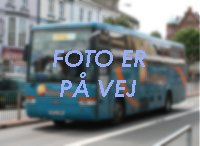Busser > Busproducenter
|
Bustypeoversigt: |
|
NEOPLAN - Gottlob Auwärter GmbH, Stuttgart (BRD) |
|
|
Nationalitet: Koncern: NEOMAN Group Firmaet grundlagt: 1935 Produktion 1998: 1.958 busser Internetadresse: www.neoplan.de Firmaets postadresse: NEOPLAN Bus GmbH (Gottlob Auwärter GmbH & Co.), Gottlob-Auwärter Straße 1-3, D-94431 Pilsting, Tyskland, tlf. 09953 - 920 - 0 |
|
|
|
|
The company was founded by Gottlob Auwärter in Stuttgart in 1935, and manufactured bodywork for bus and truck chassis. From the beginning the design of the buses produced was stylistic. After World War II an all-steel body design was developed, a rarity at that time. The company became known for its technical expertise, and by 1953 had moved away from manufacturing buses on truck chassis to a partial monocoque design with a steel tube skeleton providing the structural support, enhanced by welded side panels. The engine was moved to the rear, and the running gear and body functioned as one. In 1957 air suspension was made available, greatly improving the ride of the bus for the passenger. In 1961 a new design, the Hamburg, was unveiled at the Geneva Salon and caused a sensation in the industry. At a time when most coaches were rounded, bulbous or streamlined, the new design had clear-cut lines with edges and large windows. Developed by the founder's eldest son Albrecht and another student, Swiss Bob Lee, as part of their dissertation at Hamburg University, the design also allowed every passenger to regulate fresh air supply through a nozzle from two air ducts. Both Albrecht and Lee joined Neoplan after university. Albrect took over management of the company in 1965. Bob Lee became head of Engineering and Design. In 1964 the founder's second son, Konrad, developed a double-deck design for a service bus as part of his dissertation. The design had extremely low weight and could carry over 100 passengers. It also featured a low-frame front axle with forward-mounted steering gear that permitted a low flat floor. The double-deck principle was applied to coach design creating a revolutionary high-capacity comfortable vehicle for touring. This vehicle was known as the Skyliner, and created an image for the company that differentiated the Neoplan brand from its competitors and created interest in its products across Europe. In 1971 the Cityliner was introduced. This design had a passenger platform at a level above the driver's cab and included an onboard toilet. The vehicle also made use, for the first time, of glass-fibre reinforced plastic for certain areas of the body. In 1973 the Jetliner was introduced, featuring a large one-piece windscreen, with the driver and door windows sloping from the passenger window line down to the bottom of the windscreen level. A second manufacturing facility opened in Pilsting in 1973, and a third opening in Kumasi, Ghana in 1974 to support a large order. The double-deck Skyliner concept was taken to its ultimate conclusion in 1975 with the introduction of the Jumbocruiser, a double-deck articulated coach 18 metres long and 4 metres high. The Spaceliner, introduced in 1979 took the Cityliner concept of passenger floor level above the driver, and extended the actual floor above the cab. This kept the height of the vehicle lower than a double-decker (3.65 metres), but still allowed installation of toilets, kitchens or sleep cabins below the passenger compartment. A new fourth plant was added in 1981 in Berlin, and Bob Lee led the establishment of a fifth plant in Lamar, Colorado. In 1984 a further plant was added in Honey Brook, Pennsylvania. The US plants were later spun off into a separate, and now defunct, independent company (Neoplan USA) that used the Neoplan name under license. In 1980 Britain deregulated services over 35 miles in length. This led to intense competition on a variety of long-distance services, with operators looking to differentiate their service. Neoplan vehicles, with their futuristic design and high quality construction, began to be imported in greater numbers. These vehicles, so different from the products of the domestic coachbuilders Duple and Plaxton, became increasingly popular. In particular the Skyliner, with its head-turning design, comfort and high capacity became a status symbol for many operators of the period, in particular, Trathens Travel Services of Plymouth. The Metroliner was introduced in 1988. This vehicle was the first full monocoque bus in the world, requiring no separate chassis or skeleton. A manufacturing facility was opened in Ehrenhain in 1990. In 1992 the 15 metre tri-axle Megaliner was introduced, prompting a change in European regulations to allow non-articulated vehicles greater than 12 metres in length. The Starliner was introduced in 1996.
A new coach designed for touring was introduced in 2003 under the name Tourliner, and the Starliner was redesigned in 2004, representing arguably the most futuristic vehicle yet to bear the Neoplan name. (kilde: Wikipedia)
|
||||||||||||||||||||||||||||||||||||||||||||||||||||||||||||||||||||||||||||||||||||||||||||||||||||||||||||||||||||||||||||||||||||||||||||||||||||||||||||||
|
|
|---|



 Neoplan Bus GmbH is a German bus and coach manufacturer. The company is now a subsidiary of Neoman Bus GmbH, which itself is a part of MAN Nutzfahrzeuge AG. The company is particularly known for its futuristic designs.
Neoplan Bus GmbH is a German bus and coach manufacturer. The company is now a subsidiary of Neoman Bus GmbH, which itself is a part of MAN Nutzfahrzeuge AG. The company is particularly known for its futuristic designs. In 2001 Neoplan, or correctly Gottlob Auwärter GmbH & Co KG was acquired by MAN AG.
In 2001 Neoplan, or correctly Gottlob Auwärter GmbH & Co KG was acquired by MAN AG.




